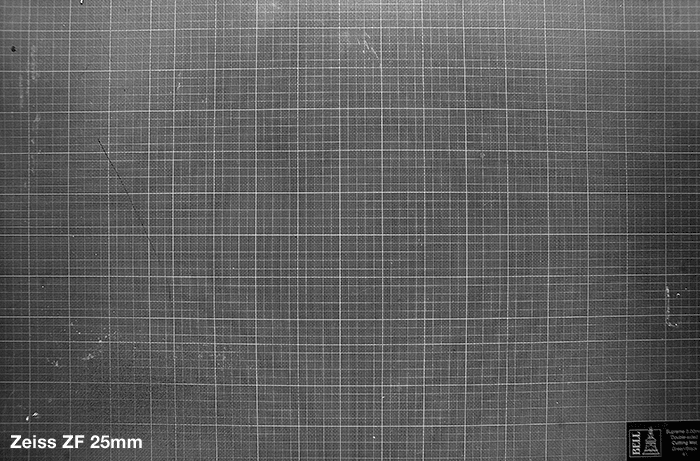[nextpage title=”Introduction (f2.8)”]
Zeiss 25mm f2.8 ZF v Canon 24mm f1.4 L Mark 1
[published january 2007]
 Arriving a little late for the big 24mm tournament last year, the Zeiss ZF 25mm was nonetheless chosen to participate in a special play off against the winner of that review: the Canon 24mm f1.4 L. The Distagon is an all-new design conforming to Carl Zeiss’ new ‘long formula’ for wide angle lenses pioneered so successful with the 21mm f2.8. It measures 65mm in length and focuses down to an astounding 6cm from the front element: practically qualifying for a ‘macro’ designation. Mindful of the importance of the right adaptor, prior to testing proper, the ZF was tested with the Fotodiox Pro version so succesfully used on the Nikon 17-35mm and 15mm AIS, as well as a thinner, Chinese-made item that seems to be quite at home on the Nikon 28mm f2.8 AIS. No differences were found (see conclusion for details). In the flesh, the Zeiss exudes high quality construction: out of the box, the focus is tight, but it does loosen with use.
Arriving a little late for the big 24mm tournament last year, the Zeiss ZF 25mm was nonetheless chosen to participate in a special play off against the winner of that review: the Canon 24mm f1.4 L. The Distagon is an all-new design conforming to Carl Zeiss’ new ‘long formula’ for wide angle lenses pioneered so successful with the 21mm f2.8. It measures 65mm in length and focuses down to an astounding 6cm from the front element: practically qualifying for a ‘macro’ designation. Mindful of the importance of the right adaptor, prior to testing proper, the ZF was tested with the Fotodiox Pro version so succesfully used on the Nikon 17-35mm and 15mm AIS, as well as a thinner, Chinese-made item that seems to be quite at home on the Nikon 28mm f2.8 AIS. No differences were found (see conclusion for details). In the flesh, the Zeiss exudes high quality construction: out of the box, the focus is tight, but it does loosen with use.
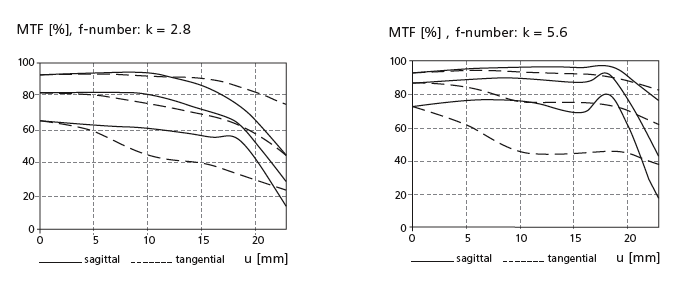
The MTF charts look promising enough, though there appears to be a steeper than expected drop off in corner resolution. We’ll see if that is borne out in practice – and whether a full frame Canon sensor can tell the difference . . .
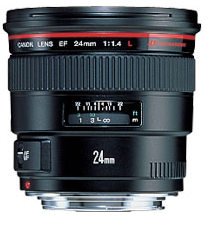 The Canon 24mm f1.4 L is a well proven design, but the lens perhaps doesn’t have the reputation it deserves. Certainly its specification is unique (there is no lens faster at this focal length) but a number of older reviews have indicated severely compromised corner performance. In my experience, this is not true. The lens has UD and aspherical elements and a floating element for close range work. We’ll see shortly how important this is. Its minimum focus is a none-too-shabby 9.6 inches and it weighs 558g against the ZF’s 480g. It’s a fraction longer, and obviously the front element is much larger: a 77mm thread on the front rather than the Distagon’s 58mm. Here are Canon Japan’s MTF figures, presumably wide open, but it’s anyone’s guess:
The Canon 24mm f1.4 L is a well proven design, but the lens perhaps doesn’t have the reputation it deserves. Certainly its specification is unique (there is no lens faster at this focal length) but a number of older reviews have indicated severely compromised corner performance. In my experience, this is not true. The lens has UD and aspherical elements and a floating element for close range work. We’ll see shortly how important this is. Its minimum focus is a none-too-shabby 9.6 inches and it weighs 558g against the ZF’s 480g. It’s a fraction longer, and obviously the front element is much larger: a 77mm thread on the front rather than the Distagon’s 58mm. Here are Canon Japan’s MTF figures, presumably wide open, but it’s anyone’s guess:
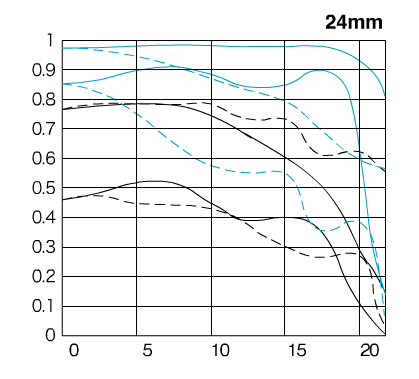 So much for the theory. How rosy are they in the garden?
So much for the theory. How rosy are they in the garden?
[nextpage title=”Resolution (f2.8)”]

The following 100% crops are taken from various parts of the image. The centre frame (Zone A) is here defined as an area of the sensor 7mm in radius located in the middle of the image circle. Samples are taken from both sides of Zone B (8–16mm distant) to check for decentering. Additional samples from near-field areas of Zones B and C (17–22mm out) will also be shown. Note that, as officially intended by Zeiss, Nikon users will never get to see Zone C or even the outer half of Zone B.
Performance at f2.8 (Zone A: Centre Frame)
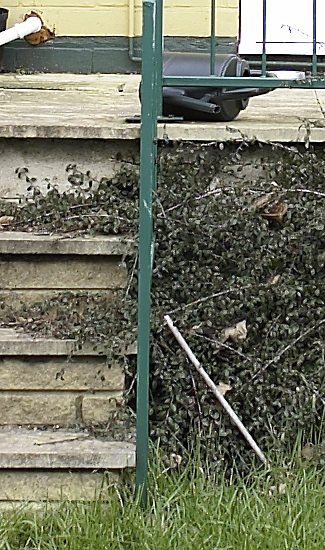 |
 |
| Canon 24mm L / f2.8 centre frame | Zeiss ZF 25mm / f2.8 centre frame |
|
0 points
|
1 point
|
From the outset, we see all the trademark Zeiss virtues in the new Distagon 25mm: beautifully ‘solid’, believable 3D rendition, punchy colour (again, this new Zeiss is a little warm) and crisp microntrast. It should be noted, though, that the Canon resolving just as well as the Zeiss, and it doesn’t suffer from purple fringing around the railings. By f2.8 the 24L has practically no vignetting, unlike the ZF25. The same exposure here yielded a hot spot in the ZF25’s frame centre, which favours it in the 100% crops above, but won’t win it any prizes in the crops below.
Performance at f2.8 (Zone B: Left Side)
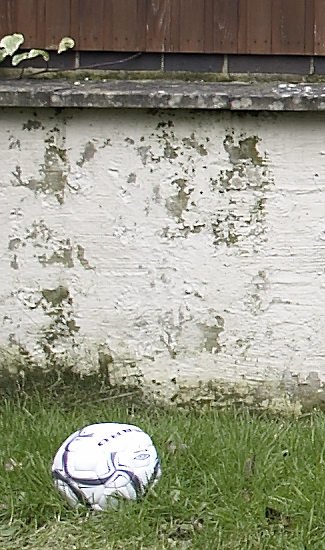 |
 |
| Canon 24mm L / f2.8 mid frame | Zeiss ZF 25mm / f2.8 mid frame |
|
1 points
|
0 points
|
Performance at 24mm: f2.8 (Zone C: Upper Left Corner)
 |
 |
| Canon 24mm L / f2.8 corner | Zeiss ZF 25mm / f2.8 corner |
|
1 point
|
0 points
|
Perhaps it isn’t fair to ask an f2.8 lens to compete wide open with a 24L two stops down from maximum aperture – but the Canon design is exceptionally versatile and priced comparably, even if it does occasionally fail to shine centre frame. Here the 24mm performs consistently well across the frame: these corners contain enough information in them to sharpen up nicely if required. However, the promise of the Zeiss ZF’s centre frame behaviour raises expectations for its performance in the f4–8 range . . .
[nextpage title=”Resolution (f4)”]
Performance at f4 (Zone A: centre frame)
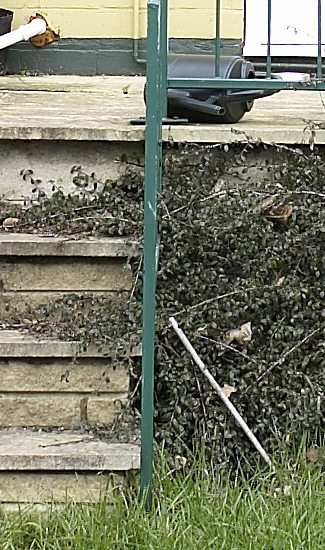 |
 |
| Canon 24mm L / f4 centre frame | Zeiss ZF 25mm / f4 centre frame |
|
0 points
|
1 point
|
Both lenses are considerably sharper centre frame at f4, and both could be considered excellent. The Zeiss once again just edges it with that lovely wiry accutance and strong spatial separation.
Performance at f4 (Zone B: near field, right side)
 |
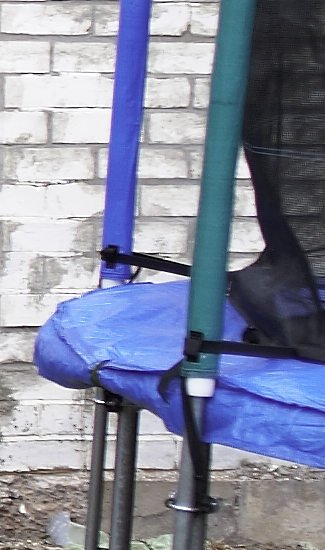 |
| Canon 24mm L / f4 mid frame | Zeiss ZF 25mm / f4 mid frame |
|
1 points
|
0 points
|
Performance at 24mm: f4 (Zone C: upper left corner)
 |
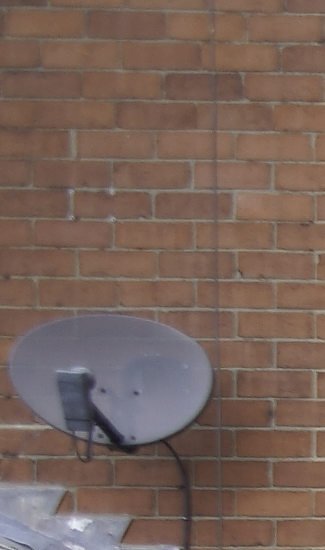 |
| Canon 24mm L / f4 corner | Zeiss ZF 25mm / f4 corner |
|
1 point
|
0 points
|
But once again the Canon looks much more attractive across the frame on average, with the exception of a sweet spot right in the middle where the Zeiss excels. Note, too, that the Zeiss ZF 25mm is not entirely free of vignetting at this aperture: the corners remain a little murky.
[nextpage title=”Resolution (f5.6)”]
Performance at f5.6 (Zone A: centre frame)
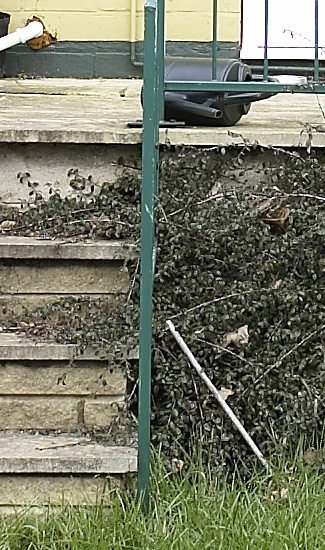 |
 |
| Canon 24mm L / f5.6 centre frame | Zeiss ZF 25mm / f5.6 centre frame |
|
0 points
|
1 point
|
The Canon’s maximum resolution peaks centre frame at f4, whereas the slower lens predictably takes until f5.6 to reach its optimal performance. This is an exceptionally fine rendition in Zone A by the Zeiss, and is perhaps the finest we’ve ever even seen at this focal length.
Performance at f5.6 (Zone B: right side)
 |
 |
| Canon 24mm L / f5.6 mid frame | Zeiss ZF 25mm / f5.6 mid frame |
|
0 points
|
1 point
|
By f5.6 the Zeiss ZF 25mm is starting to shake off the disadvantage of its smaller maximum aperture and for the first time, its Zone B performance exceeds that of the Canon 24mm L.
Performance at 24mm: f5.6 (Zone C: upper left corner)
 |
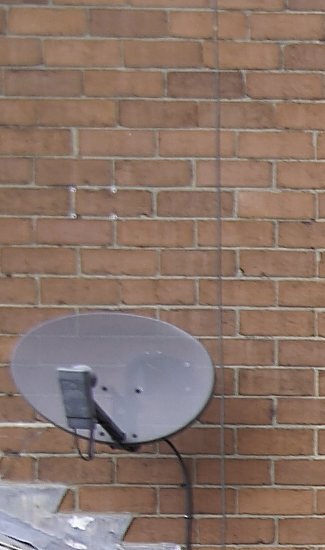 |
| Canon 24mm L / f5.6 corner | Zeiss ZF 25mm / f5.6 corner |
|
1 point
|
0 points
|
Performance at 24mm: f5.6 (Zone C: upper right corner)
 |
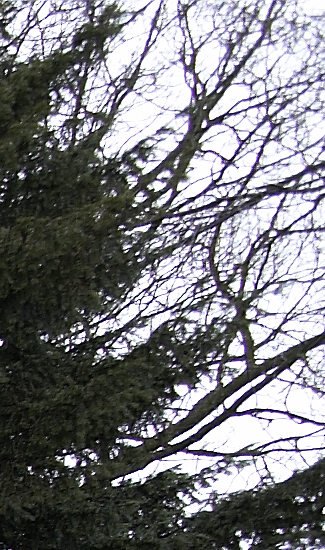 |
| Canon 24mm L / f5.6 corner | Zeiss ZF 25mm / f5.6 corner |
However, the Canon retains its superiority in the corners – for resolution, at least. Note that whereas the Canon is relatively unaffected by lateral CA at wide apertures, we see purple fringing buzzing about the branches at f5.6 and up. The ZF 25mm by contrast loses its CA gremlins at f4 and here at f5.6 makes a fine showing.
[nextpage title=”Resolution (f8)”]
Performance at f8 (Zone A: centre frame)
 |
 |
| Canon 24mm L / f8 centre frame | Zeiss ZF 25mm / f8 centre frame |
|
0 points
|
1 point
|
These are now very, very close. For me, the Zeiss still presents the scene with greater elan. Both lenses are now slightly past their peak in terms of centre frame resolution, but I’m not sure the sensor can tell the difference. The challenge from hereon in is to resists the more conspicuous, but inevitable, effects of diffraction.
Performance at f8 (Zone B: upper right)
 |
 |
| Canon 24mm L / f8 mid frame | Zeiss ZF 25mm / f8 mid frame |
|
0 points
|
1 point
|
It’s a shame to have to dock a point from either of these, because across the frame performance is exceptionally fine. However, the Zeiss is clearly again just that bit more special: note the fine detail in the creeper on the brickwork . . . .
Performance at 24mm: f8 (Zone C: upper left corner)
 |
 |
| Canon 24mm L / f8 corner | Zeiss ZF 25mm / f8 corner |
|
1 point
|
0 points
|
But still the Canon owns the corners, even at f8. You may have already noticed that both lenses are extremely well corrected for distortion and display similar subtle barrel distortions sweeping outwards at the corner. Coming inboard from the extreme corner, but remaining in Zone C, we see that the Canon’s superiority lies only in the extreme corners: across the rest of the frame, the Zeiss has caught up big style.
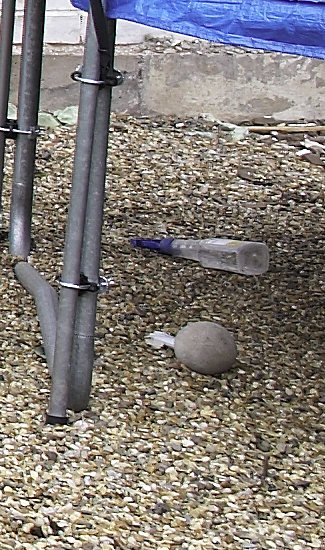 |
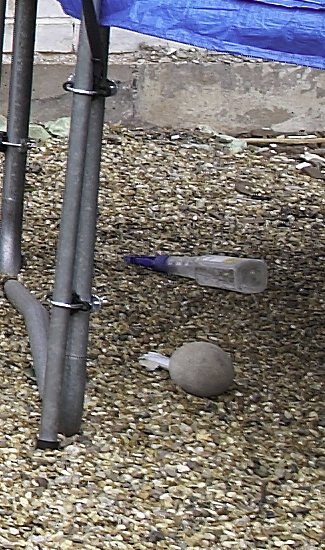 |
| Canon 24mm L / f8 corner | Zeiss ZF 25mm / f8 corner |
[nextpage title=”Resolution (f11)”]
Performance at f11 (Zone A: centre frame)
 |
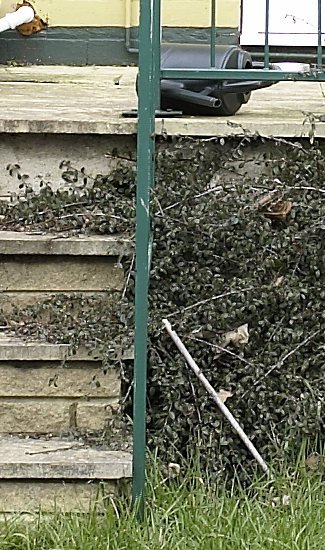 |
| Canon 24mm L / f11 centre frame | Zeiss ZF 25mm / f11 centre frame |
|
0 points
|
1 point
|
Again almost too close to call. The Zeiss has a slightly more pleasing quality about its low end tones here, which are more solidly drawn, so we’ll let it sneak an extra point rather than call it a draw.
Performance at f11 (Zone B: upper right)
 |
 |
| Canon 24mm L / f11 mid frame | Zeiss ZF 25mm / f11 mid frame |
|
1 point
|
1 point
|
Perhaps the ZF 25mm has a little more ‘bite’ in these Zone B crops, but we gave the Zeiss the benefit of the doubt in Zone A, so I think we have to call this one a draw: both are superb.
Performance at 24mm: f11 (Zone C: upper left corner)
 |
 |
| Canon 24mm L / f11 corner | Zeiss ZF 25mm / f11 corner |
 |
 |
| Canon 24mm L / f11 corner | Zeiss ZF 25mm / f11 corner |
|
1 point
|
0 points
|
The Canon just holds on to its extreme corner superiority, but even there this pair are now very close at f11. In the 17-19mm section of Zone C, the Zeiss is perhaps a fraction sharper, but bear in mind that its longer focal length is giving it a few more sensor pixels to render the meshwork on this netting. The Zone C point just about goes to the Canon, but it’s very close.
[nextpage title=”Resolution (f16)”]
Performance at f16 (Zone A: centre frame)
 |
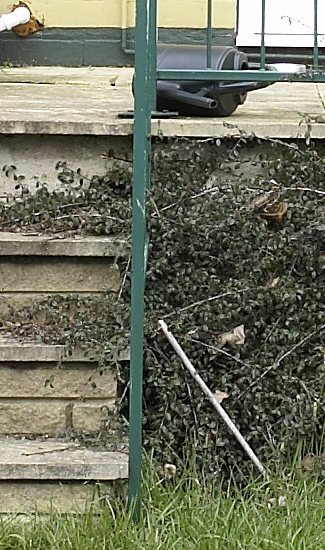 |
| Canon 24mm L / f16 centre frame | Zeiss ZF 25mm / f16 centre frame |
|
0 points
|
1 point
|
Allowing for both lenses being well over the hill at f16 for centre frame sharpness, both designs are commendably delivering most of the f8 goodness still. The very pernickety may agree that the ZF25 still looks cleaner.
Performance at f16 (Zone B: upper right)
 |
 |
| Canon 24mm L / f16 mid frame | Zeiss ZF 25mm / f16 mid frame |
|
0 points
|
1 point
|
Barring subtly different styles of presentation, these are now very similar. The slightly higher contrast levels of the Zeiss are clarifying details in the brickwork not evident in the Canon shot, so it just deserves the extra point.
Performance at 24mm: f16 (Zone C: upper left corner)
 |
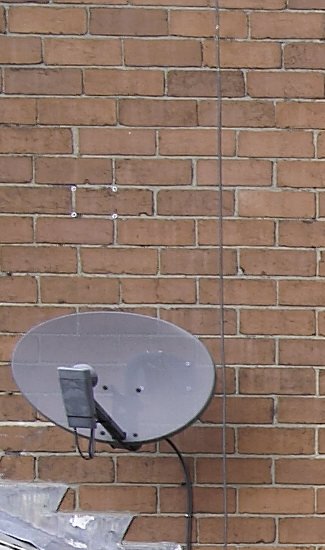 |
| Canon 24mm L / f16 corner | Zeiss ZF 25mm / f16 corner |
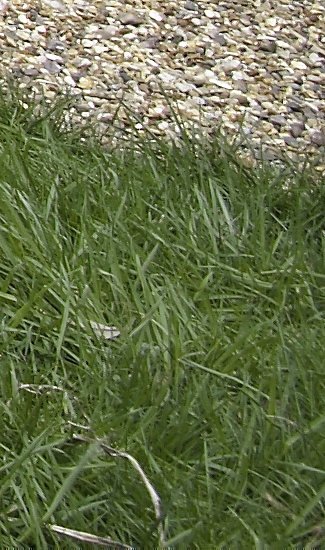 |
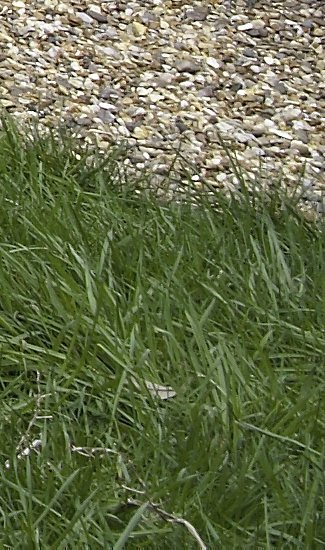 |
| Canon 24mm L / f16 corner | Zeiss ZF 25mm / f16 corner |
|
0 points
|
1 point
|
Though the margin is very slight, at f16 there’s little doubt in my mind that the Zeiss ZF 25mm is better across the frame and only at this aperture does it outperform the Canon L’s corners.
[nextpage title=”Distortion / Macro Performance”]
Rollover the Zeiss ZF 25mm image to show the Canon 24mm L version. Two points to the Canon here, I think.
Close Range Performance / Distortion: Corner Detail


The distortion chart above was shot at f5.6 at a distance of two feet (60cm) and was carefully focus bracketed to ensure correct rendering. As you can see, the distortion pattern of both lenses is that of barrel (negative) in the centre frame, reversing positively in the corners. Here’s Zeiss’ own distortion data, followed by an estimate of the Canon 24L’s (official distortion charts are very hard to come by):
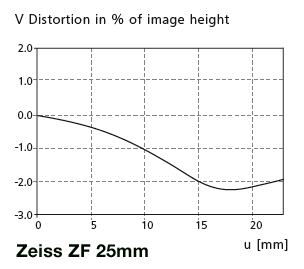

I reshot the above with the ZF several times, but couldn’t get a sharp corner at any aperture below f16 at that range – which is surprising, because the lens appears to have been designed with a 6cm minimum focus capability, but according to the Zeiss web site, no floating element? The Canon L, with floating element performs as well at distance as it does in the macro range . . . deduct 2 points for the ZF, then.
[nextpage title=”Flare & Ghosting”]
Zeiss ZF 25mm f2.8 v Canon 24mm f1.4 L
Flare / Ghosting


That’s T* for you . . . outstanding control of flare in this provocative worst case scenario image: a naked point light source at close range, raking across the front element. The Canon 24mm L (bottom) is in all sorts of trouble: elongated ghosts (internal reflections) and blobs all over the place, and a wide low contrast halo around the light. These artefacts rarely show up unless you do something this stupid, of course, but it’s much safer to leave the sun in shot with the Distagon than it is with the L. Two points for the Zeiss.
Here’s those halos in close up (100% view, unsharpened): again Zeiss first, followed by the Canon L.


[nextpage title=”Chromatic Aberration”]
Both lenses suffer from chromatic aberration, in different ways. The Zeiss picks up some red/purple fringing at f2.8 and f4, with either adaptor tested. Here the Canon (topmost image) is clean . . .

It’s fairly prominent here at f2.8 in the Zeiss image. The Canon shot is on the left . . .
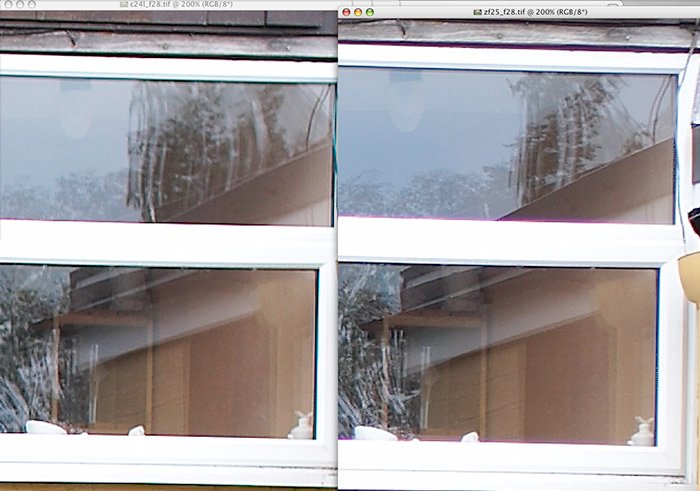
The Zeiss’ lateral CA persists all over the frame, not just in the corners. The purple fringing is still evident at f4. The Canon by contrast has slightly stronger CA when stopped down. The following samples at at f11. Again the Canon samples are on the left.
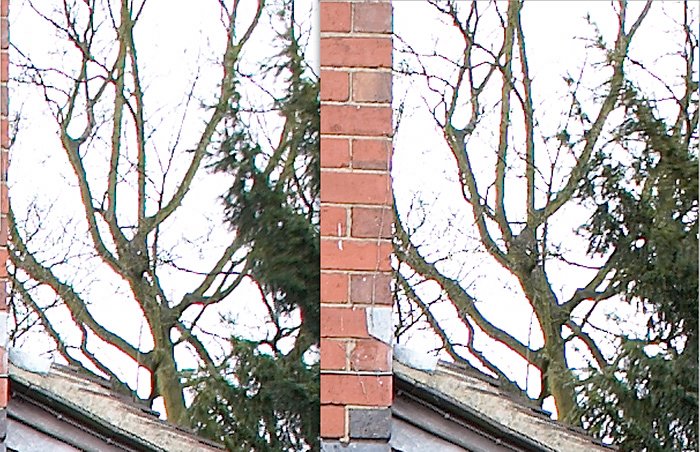
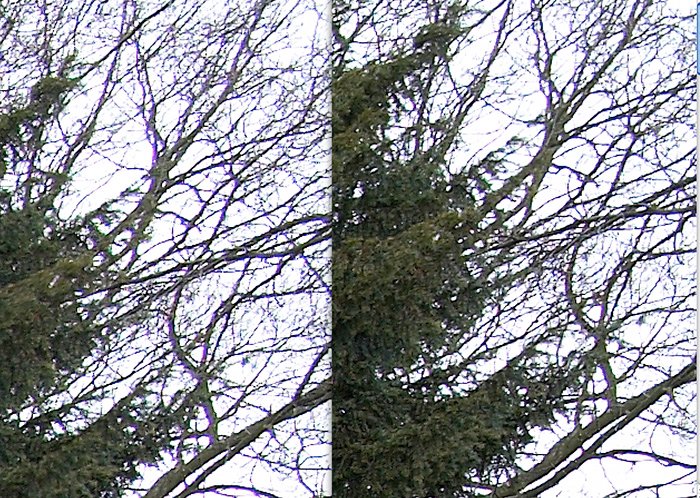
I don’t think we can declare a winner in this category: both lenses are affected to some extent: the Canon suffers a little more at small apertures, the Zeiss in the f2.8–f4 range.
[nextpage title=”Conclusion”]
Ultimately, these are two very closely matched. The Zeiss ZF 25mm f2.8 would have made the 24mm World Cup final had the lens been available when the review was conceived: it seems to be a fraction more capable than the Olympus 24mm f2.8; it’s certainly a big step up from the AIS Nikon 24mm (f2 and f2.8), so it should by rights find a place on many Nikon bodies. But is it better than the Canon 24mm f1.4 L?
Bear in mind that the following score, a tally of comparisons made throughout the review, is a broad measure of the lenses’ overall competence: it’s an indicator, not a verdict – in a test this close, the right lens for you will be determined by your priorities more than each contender’s abilities.
|
Canon 24mm f1.4 L
|
Zeiss ZF 25mm f2.8
|
|
12 points
|
13 points
|
By all means review the points as they were awarded, and if you feel I’ve been unfair at any point, make your own adjustments. We could add an extra point or two to the Zeiss because of it’s superior 3D rendering and slightly more vivid colour. Equally we could deduct a point or two for vignetting or abysmal near-field performance. Maybe the Canon deserved the vital equalising point for its handling of CA. But I think the scoreline is a fair reflection of the contest.
Is there an adaptor problem? The Zeiss’ wide aperture performance was not quite up to expectations: there is unusual CA and poor close-focus performance – all the usual adaptor-related suspects. Here are 200% views of a different scene shot with the Fotodiox Pro Nikon/EOS adapter, and a thinner Chinese-made version I have used succesfully with the Nikon 28mm f2.8. As you can see, there is no discernible difference. A separate test conducted at close range confirmed that nothing is to be gained by swapping adaptors.

I believe what we are seeing is how far Zeiss has tuned this lens for the smaller Nikon DX sensor. Remember, if you’re a D2X user, you can ignore all the Zone C test results and some of the Zone B images too. The ZF’s lack of a floating element won’t affect your close range performance becuase all the ghastly resolution loss occurs in Zone C. Perfect sense for the Nikon buyer; not much help for the Canon user.
In summary, then, the Canon 24mm f1.4 L is a wide aperture master: let’s not forget that it has a huge two stop advantage over the Zeiss. The Zeiss is better throughout the aperture range centre frame, but needs f8 for critically sharp corners. However, stopped down the ZF is unrivalled at this focal length: resolution, flare, contrast, CA: the whole package comes together in the f8–f16 range and adds up to something unique, with vintage Carl Zeiss mojo.
But, and it’s a big but . . . the Canon 24L is also very, very good. What you have to ask is whether that little extra bit of magic and sparkle is worth the loss of auto focus, auto aperture, and two whole stops: f1.4, f1.8, f2.0, f2.4 . . . there’s a world of creative potential and light gathering in there that the Zeiss will never know. You will get more keepers more often with the Canon – no doubt; but the shots you nail with the Zeiss at f8 and f11 will be special – even on a 1Ds II.
For Nikonians (denied the loveliness of the 24L), the ZF 25mm is the best prime at this focal length by a considerable margin. If you can live without AF, it’s a no brainer: buy now. However, among Canon users, I fear that all but a select cadre of small aperture purists will be tempted by the more accessible charms of the 24mm f1.4 L.

